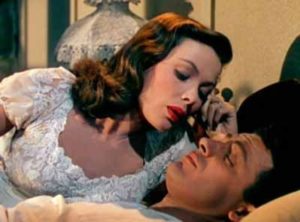STUDIO: Criterion | DIRECTOR: John M. Stahl | CAST: Gene Tierney, Cornel Wilde, Jeanne Crain, Vincent Price, Mary Philips, Ray Collins, Darryl Hickman
RELEASE DATE: 3/24/20 | PRICE: Blu-ray $27.87 DVD $21.99
BONUSES: Interview with critic Imogen Sara Smith
SPECS: NR | 110 min. | Film noir melodrama | 1.37:1 widescreen | monaural |
The best example of the very small subset of film noirs that are called “color noirs,” Leave Her to Heaven (1945) is not only a great noir, it is also a great melodrama that features unforgettable images of its star, Gene Tierney (Whirlpool).
It’s a beautiful example of the kind of craftsmanship that can be found in vintage Hollywood major studio films, but it also does say a lot about men’s fear of a “possessive” woman and the way in which a woman who rejected certain norms in the 1940s — most especially the “sacred” institution of motherhood — was instantly perceived as “evil.”
For the film – which was a box-office hit at the time of its release — definitely has the psychological undercurrents that are found in noir, but its heroine, played by Tierney, is far from the “black widow” archetype in many noirs (or even the obscure object of desire that Tierney played a year earlier in the perfect Laura). She is a woman with a father fixation who falls so deeply in love with a man that she can’t stand anyone intruding on their love – even a relative or a child.
The plot is the stuff of great melodrama (and it was indeed based on a bestselling novel). The aforementioned love junkie, Ellen (Tierney), falls deeply in love with and marries novelist Richard (Cornel Wilde, The Naked Prey), and is willing to eliminate any obstacle to their relationship. In the film’s best-remembered scene (evoked on the box art for this Criterion release), she allows his disabled brother (Darryl Hickman) to drown while swimming so that he will not be “in the way” of their affection.
She moves on from there to “deal” with her pregnancy, throwing herself down a staircase to miscarry the baby. The third act is a court trial in which the prosecutor (a wonderfully over-the-top Vincent Price) — who happens to be Ellen’s jilted ex-boyfriend — accuses Richard of murdering Ellen in a plot that she herself set up before committing an oblique form of suicide.
 These overwrought actions take place in a beautifully bucolic environment, with gorgeous rural images courtesy of cinematographer Leon Shamroy (Love Is a Many-Splendored Thing), who won an Oscar for his work on the film. The characters wear primary colors that blend in with their environment, while Ellen is “color-coded” in different scenes to reflect her mood and behavior.
These overwrought actions take place in a beautifully bucolic environment, with gorgeous rural images courtesy of cinematographer Leon Shamroy (Love Is a Many-Splendored Thing), who won an Oscar for his work on the film. The characters wear primary colors that blend in with their environment, while Ellen is “color-coded” in different scenes to reflect her mood and behavior.
Director John M. Stahl, who was a master of melodrama (referred to as “women’s pictures” in the Golden Age), accents Tierney with appropriate noir lighting at points, but in other key scenes she is photographed with no Expressionistic distortions, as in the memorable moment when she talks about how she loathes being pregnant (“I hate the little beast — I wish it would die!”).
As is the case with many melodramas and noirs, Ellen is not only the most interesting character in the film (as the rest are bland stereotypes — except for Price’s prosecutor), she is also the most sympathetic. Her crazed passion for her (excessively boring) husband leads her to extreme behavior, but she is clearly motivated entirely by jealousy and fear that he will leave her. She is, in effect, the kind of character who is far more interesting to watch than a virtuous, homespun heroine.
Each member of the cast does an admirable job of incarnating their role, but the way the film is scripted it’s Tierney’s show all the way. She gives a wonderfully subdued yet manic performance and is a vision in all of her scenes, with her blue-green eyes and ruby red lips seeming like special effects to make her stand out against the natural “country” environment that Ellen inhabits.
This Criterion release has only one visual supplement, an interview with critic Imogen Sara Smith, who discuses Stahl’s work and Tierney’s character in detail. She outlines how Stahl’s most famous films (the original Imitation of Life and Magnificent Obsession) were marked by “female devotion” and that Ellen is sketched as a “demonic caricature” of the average woman of the 1940s. Stahl and Shamroy’s visuals are also explored, in particular the use of deep focus and the evocative and stylish approach to color.
An essay by crime novelist Megan Abbott is included in the booklet. Abbott directly explores the ways in which Ellen’s actions and dialogue reflected the secret longings of women viewers in the immediate post-war period:
“…Ellen says the things women think but cannot say. Her unspeakable acts may have offered female viewers a cathartic relief from the era’s gender imperatives and an exorcism of their own forbidden feelings and longings.”
Plus, she looks incredibly chic in sunglasses while watching her tedious teenage brother-in-law drown.
|
Buy or Rent Leave Her to Heaven
|
|---|
Leave a Reply